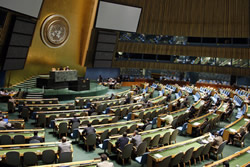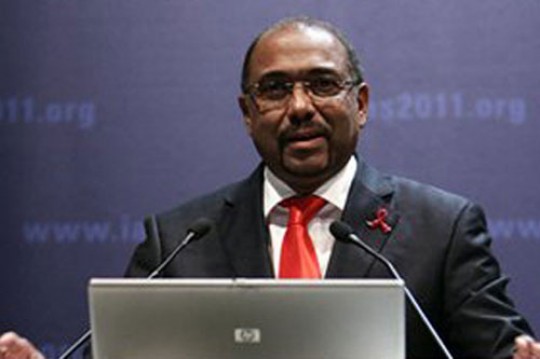UN invites young people to create its HIV/AIDS strategy through social media
UN invites young people to create its HIV/AIDS strategy through social media
25 October 2011
The project, CrowdOutAIDS.org, run by the Joint UN Programme on HIV/AIDS (UNAIDS), will run for a period of two months in which anyone aged 15 to 29 will be able to submit and share their ideas and proposals for the strategy.
The initiative’s name alludes to the popular concept of crowdsourcing, which consists of letting large undefined groups of people collaborate and come up with innovative solutions for tasks traditionally performed by individuals.According to a news release issued by UNAIDS, around3,000 young people aged 15 to 24 become infected with HIV on a daily basis
“We’re asking youth around the world to debate, draft and work with UNAIDS to implement this new strategy,” said Michel Sidibé, Executive Director of UNAIDS. “It is absolutely critical that we engage young people – not as recipients of our message but as the actors and creators of change.”
CrowdOutAIDS.org will use a four-step model of collaboration which will allow participants to use a range of social media platforms to connect, share and collaborate on a new strategy that speaks to them and addresses the key issues they face when it comes to HIV/AIDS.
Participants will be able to use their personal social networks such as Facebook, Twitter, Orkut and personal blogs, to spread the word about the project and then discuss their ideas through online forums and other collaborative platforms such as Google Docs. They will also be able to shape the new strategy and see it transform from an initial draft to completion through a wiki-platform, which allows users to add and edit content in a collaborative way.
According to a news release issued by UNAIDS, around 3,000 young people aged 15 to 24 become infected with HIV on a daily basis, making their involvement essential for an effective response to the epidemic.
“It is important to involve young people in policy development in order for our views, expectations and aspirations to be fully represented,” said Jennifer Ehidiamen, a blogger and journalist from Nigeria and online content curator for the project’s website.
“CrowdOutAIDS.org is an innovative way to build a strong community, interested in sharing solution-based ideas and actions on AIDS,” she said.
###
Young people to write new UNAIDS strategy on youth and HIV
UNAIDS will use crowdsourcing technologies and social media platforms to engage young people in developing AIDS policy
GENEVA, 25 October 2011
The Joint United Nations Programme on HIV/AIDS (UNAIDS) is launching CrowdOutAIDS.org, an online collaborative project to crowdsource its new strategy on youth and HIV—a first in the UN system.
Crowdsourcing is a technique used to rapidly engage large numbers of interested people to develop strategies, solve problems or propose relevant and fresh ideas. With around 3000 young people aged 15-24 becoming infected with HIV daily, leveraging new modes of communication and online collaboration with young people is essential for an effective response to HIV.
“We’re asking youth around the world to debate, draft and work with UNAIDS to implement this new strategy,” said Michel Sidibé, Executive Director of UNAIDS. “It is absolutely critical that we engage young people—not as recipients of our messages but as the actors and creators of change.”
CrowdOutAIDS.org is a completely new way for UNAIDS to develop policy on HIV. It will use crowdsourcing technologies and familiar online tools such as Facebook, Twitter and Renren to ensure youth engagement and action in the AIDS response.
CrowdOutAIDS.org follows a four-step model and is open to anyone aged 15-29. Young people will be able to shape the new strategy from conceptualization to final drafting via a wiki-platform.
“It is important to involve young people in policy development in order for our views, expectations and aspirations to be fully represented,” said Jennifer Ehidiamen, a blogger and journalist from Nigeria, and online content curator for CrowdOutAIDS.org. “CrowdOutAIDS.org is an innovative way to build a strong community, interested in sharing solution-based ideas and actions on AIDS.”
The project will run over a period of two months with the final crowdsourced strategy being produced in January, 2012. To find out more, visit www.CrowdOutAIDS.org, and follow @UNAIDS and #CrowdOutAIDS on Twitter.
###
> United Nations (UN).
 The United Nations was established on 24 October 1945 by 51 countries committed to preserving peace through international cooperation and collective security. Today, nearly every nation in the world belongs to the UN: membership totals 192 countries.
The United Nations was established on 24 October 1945 by 51 countries committed to preserving peace through international cooperation and collective security. Today, nearly every nation in the world belongs to the UN: membership totals 192 countries.
When States become Members of the United Nations, they agree to accept the obligations of the UN Charter, an international treaty that sets out basic principles of international relations. According to the Charter, the UN has four purposes:
- to maintain international peace and security;
- to develop friendly relations among nations;
- to cooperate in solving international problems and in promoting respect for human rights;
- and to be a centre for harmonizing the actions of nations.
###
* The above story is adapted from materials provided by United Nations (UN)
** More information at United Nations (UN)





















